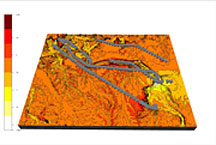- Number 339 |
- June 13, 2011
A cool new way to stretch the capacity of existing power lines

INL researchers use data from the
weather stations to create a 3-D mean
wind speed map. The scale shows wind
speeds in meters per second.
Wind power researchers at DOE’s Idaho National Laboratory think we can move more electricity through the transmission lines we already have without breaking the bank. The key is to pay close attention to the weather. Just as a wisp of wind can make a sultry summer day much more bearable, a breeze can ease the journey for electricity traveling through hot power lines. A light breeze blowing at a right angle to a high-voltage line can cool the line enough to increase the amount of current it can safely carry by around 30 percent, says INL wind power expert Gary Seifert.
In the continental United States, some 500 power companies operate a massive, complex network of more than 160,000 miles of high-voltage transmission lines. The difference in time and cost between using existing transmission lines or new ones can make or break a new wind or solar farm.
INL is investigating a technique to dynamically rate transmission lines by taking advantage of concurrent cooling potential. With support from DOE's Office of Energy Efficiency and Renewable Energy Wind and Water Power Program, INL and Idaho Power Company are investigating the use of climatology data to calculate dynamic line ratings.
They are working in a windy part of southern Idaho to translate detailed wind and temperature information into dynamic line transmission ratings — real-time estimates of how much current each 500-meter segment of high-voltage line can safely carry. Idaho Power and DOE’s office of Energy Efficiency and Renewable Energy are funding the wind cooling research, which could help make electricity cheaper and accelerate renewable energy projects.
Using dynamic line ratings to manage high-voltage lines in such places could help increase the overall efficiency of power transmission and lower the cost of power to customers. A long-term record of dynamic line ratings could also help power utilities identify portions of transmission lines that act as bottlenecks, says INL wind power researcher Kurt Myers. Upgrading these bottleneck stretches could significantly increase the transmission capacity of the entire line at a fraction of the cost of replacing the whole line or putting up a new one.[Nicole Stricker, 208/526-5955,
nicole.stricker@inl.gov]
